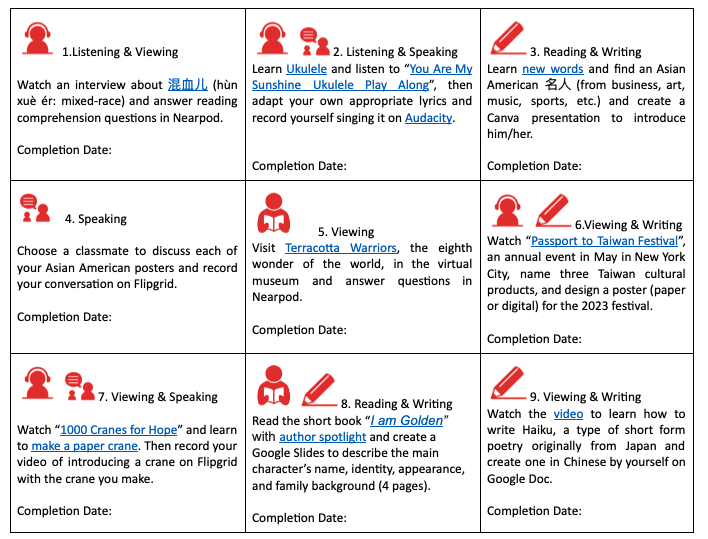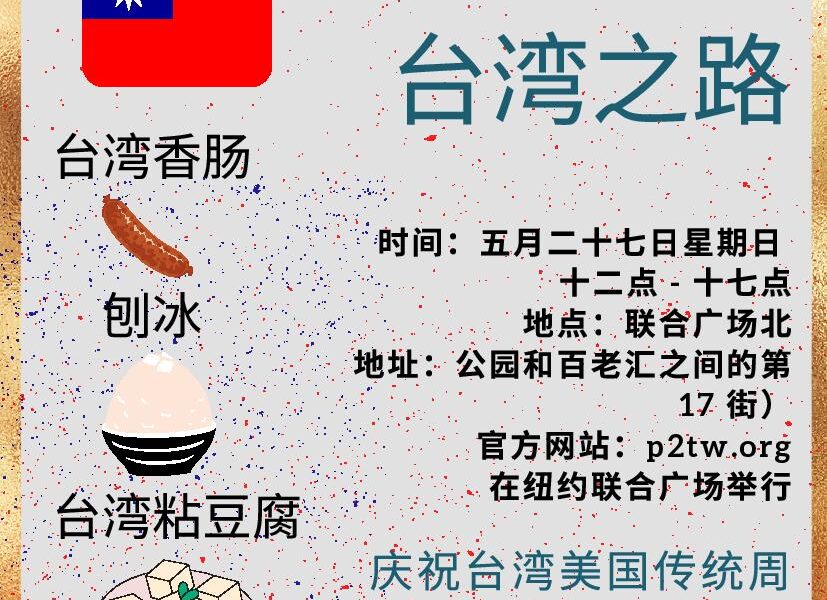Asian American Pacific Islander Heritage Month Digital Choice Board
By Wenjing Huang, Mandarin Teacher, Wildwood School

DOI: https://www.doi.org/10.69732/CSMH5047
Introduction
Do you find that your language students’ attention diminishes at the end of the semester or school year? Have you thought about providing more choices into your curriculum to increase learners’ autonomy and engagement, even at the novice level? You can use easy and simple digital tools during this mid and post-pandemic to re-engage your tech-savvy Gen-Z students. I used a digital choice board for this purpose last May.
AAPI stands for Asian American and Pacific Islander. It includes all people of Asian, Asian American or Pacific Islander ancestry. Asian American and Pacific Islander (AAPI) Heritage Month is an annual celebration that began in the late 1970s to recognize the historical and cultural contributions of individuals and groups of AAPI heritage. Since 1990, the month of May has been officially designated as AAPI Heritage Month because it commemorates the arrival of the first immigrants from Japan to the United States on May 7, 1843 and celebrates the completion of the transcontinental railroad by over 20,0000 Asian immigrants on May 10, 1869.
Given the significance of these anniversaries, May is the perfect time to highlight and celebrate the contributions and achievements of AAPI with students and to deepen the theme of diversity, equity, and inclusion in classrooms when the school year comes to an end.
In order to differentiate learning and give students more autonomy and more choices, I implemented technology-enhanced choice boards into the AAPI unit for my novice learners in Chinese classes, which they can use to dive into authentic resources and current events that are relevant to their daily life and interests in the last few days of school when their focus is on field trips, graduation, holidays, and summer or winter vacation. This assignment can also be adapted for other holidays or occasions.
What is a Choice Board?
A choice board is a grid that allows students to choose the activities they will complete. Each square has an activity which relates to a certain skill or to one of the multiple intelligences. The level of difficulty of the choices can vary or stay consistent. When students in a particular class have very different ability levels, teachers can further adapt the choice board structure with more than one choice board, so that different levels of learners have different work that is at the appropriate degree of difficulty for them.
Benefits of Using Choice Boards
Here are some benefits of using choice boards from Gardner (2006), Thousand, Villa & Nevin (2007). Choice boards:
- Provide a variety of learning opportunities;
- Match activities to address content with learning preferences;
- Target the individual learning preferences of each student;
- Encourage greater success and a greater desire to continue to be successful students;
- Facilitate students’ development into lifelong learners;
- Highlight the importance of the individual student;
- Increase communication between educators and students.
AAPI Digital Choice Board
I chose to enhance my AAPI unit with a digital choice board for a variety of reasons:
- Links to digital tools are easily incorporated into digital choice boards;
- It helps to tap into different learning preferences and multiple intelligences with a variety of formats such as audio recording, video recording, drawing, typing, and multiple creation tools to truly maximize the learning environment;
- It is quick and easy for students to navigate various websites and applications;
- It is kept in one place with everything that students need to access and submit their work;
- It is easy for teachers to check students’ progress and give timely feedback and grading.
The goals for my middle and high school novice-level learners in using the choice board are the following:
- to increase the awareness of different AAPI culture elements;
- to understand the main idea of short and simple texts for familiar topics;
- to present information on family topics using a series of simple sentences.
Offering the Choice Board below in May helped to increase the variety of material that could be covered in a busy school year by offloading some of the work to students themselves, without taking up much class time and allowing them to work at their own pace. Students are directed to complete at least three assignments each week.

These nine AAPI assignments focus on the three modes of communication that can be integrated with novice-level Chinese classes and students use words and sentences they have learned in year one and year two courses to understand and describe names, nationality, family identity, appearance, and location. In addition, they explore a variety of resources such as an interview video, music, a reading text, a children’s book, virtual tours, etc. to be exposed to Asian American, Hawaiian, Chinese, Japanese, and Taiwanese culture elements. The text of each assignment appears in a table below the picture.

| 1.Listening & Viewing
Watch an interview about 混血儿 (hùn xuè ér: mixed-race) and answer reading comprehension questions in Nearpod. Completion Date: |
2. Listening & Speaking
Learn Ukulele and listen to “You Are My Sunshine Ukulele Play Along”, then adapt your own appropriate lyrics and record yourself singing it on Audacity. Completion Date: |
3. Reading & Writing
Learn new words and find an Asian American 名人 (from business, art, music, sports, etc.) and create a Canva presentation to introduce him/her. Completion Date: |
| 4. Speaking
Choose a classmate to discuss each of your Asian American posters and record your conversation on Flipgrid. Completion Date: |
5. Viewing
Visit Terracotta Warriors, the eighth wonder of the world, in the virtual museum and answer questions in Nearpod. Completion Date: |
6.Viewing & Writing
Watch “Passport to Taiwan Festival”, an annual event in May in New York City, name three Taiwan cultural products, and design a poster (paper or digital) for the 2023 festival. Completion Date: |
| 7. Viewing & Speaking
Watch “1000 Cranes for Hope” and learn to make a paper crane. Then record your video of introducing a crane on Flipgrid with the crane you make. Completion Date: |
8. Reading & Writing
Read the short book “I am Golden” with author spotlight and create a Google Slides to describe the main character’s name, identity, appearance, and family background (4 pages). Completion Date: |
9. Viewing & Writing
Watch the video to learn how to write Haiku, a type of short form poetry originally from Japan and create one in Chinese by yourself on Google Docs. Completion Date: |
In this choice board is a list of technology tools needed for each assignment which students are all familiar with and use on a daily basis, available to students with a variety of learning preferences.

Here are some of the students’ written work examples based on their choices.




Feedback and Reflection
The questions below were shared with students when collecting their feedback for this choice board.
- Have you seen a choice board before?
- Are the tasks easy or difficult?
- How did you choose which tasks to complete?
- What did you learn when doing these?
After the unit, the majority of students reported that they had not seen or tried this in other classes and subjects. They all enjoyed doing these tasks and some of them chose the ones that looked most interesting to them. Some said the tasks were of mixed difficulty levels. Some mentioned they learned Asian culture, certain Chinese sentence structure, and about Asian celebrities from doing this. And others liked this opportunity to connect to their heritage and culture.
As this is my first-time using a choice board for an AAPI unit, I was able to get to know my students from other perspectives and understand their hobbies and passions. I was surprised to see that a couple of students did the Haiku poem in Chinese, which I thought was a challenging task but it turned out that some of them already knew its format. In addition, more students chose reading, viewing, and writing compared to speaking tasks. In the future, for an AAPI celebration, I would like to include more south Asian, southeast Asian, central Asian, west Asian, and Pacific Islander elements for a balanced and diverse representation of an AAPI choice board. Besides, a connection to a wider range of content such as architecture, film, dance, clothing, plants, animals, tourism, health, weather and climate, environment, etc. is also a direction I would like to explore.
Conclusion
Digital choice boards are helpful in engaging Generation Z learners in language learning, whether for online, hybrid, or onsite environments. It features technology tools and differentiated instruction, the two key components in teaching. They provide learners with the power to choose “how” to learn and to take the lead in areas they feel more confident in and have more control over. On the other hand, they enable educators to identify student interests and preferences to stimulate active learning and engagement while better facilitating mixed-level world language classrooms. I find choice boards to be mirrors that show me the other side of students’ strengths and talents which they may not have the opportunity to demonstrate through regular class activities.
References
Croteau, J. (2022, May 13). 18 Student Activities for AAPI Heritage Month. We Are Teachers. https://www.weareteachers.com/aapi-heritage-month-activities/
The History of Asian Pacific American Heritage Month. (2022, January 28). Arlington Public Schools. https://www.apsva.us/aapi-heritage-month-history/
History.com Editors. (2022, April 5). Asian American and Pacific Islander Heritage Month. HISTORY. https://www.history.com/topics/holidays/asian-american-pacific-islander-heritage-month
5 Reasons to Use DIGITAL Choice Boards in the Classroom. (2022, May 23). The Techie Teacher®. https://www.thetechieteacher.net/2017/10/5-reasons-to-use-digital-choice-boards.html
Thousand, J.S., Villa, R.A., & Nevin, A.I. (2007). Differentiating Instruction: Collaborative Planning and Teaching for Universally Designed Learning. Corwin Press.
Gardner, H.E. (2006). Multiple Intelligences: New Horizons in Theory and Practice (Revised, Updated ed.). Basic Books.

